VW introduced the iconic hot hatch in 1976, well over 40 years ago! From its light, nimble beginnings (the first Mk1 weighed almost half the current models!), the GTI’s come quite a long way, in power and style.
Forty years is a long time and VW has constantly updated the standard-setting Golf and GTI with larger bodies, bigger engines, better suspension, and more and more creature comforts. Today’s GTI is a far cry from the original Mk1 – a bare bones ride with no AC, no power steering, and manual windows (for those of us who can’t remember – you clasp a small handle and move your hand in a circular motion).
Why Plaid? It was inspired by a VW designer’s travels around Great Britain in the 1960s and 70s.
And of course, the aesthetics of the GTI changed with each subsequent model update as well. VW is famously conservative with the Golf’s styling updates. When compared to other cars where new styling comes way out of left field (consider how much the Mustang has changed over the decades, for example), you can always immediately tell when you see a Golf – they all have that distinct Golf-ness about them.
However, while the outside’s changed relatively little, VW’s been a bit more free with the interior. VW’s kept up with the times, constantly updating the styling to match the current mood of consumers and auto makers.
Looking at Plaid Seats Across the Years
Scrolling through photos of the GTI’s interior over the last 40 years is almost like a history lesson unto itself. Today, let’s educate ourselves by traveling back in time to look at each GTI’s interior styling to see just how far they’ve really come!
MkI – “Red is Power”
VW released the Golf GTI in 1976, two years after the first Golf rolled off the line. VW initially expected to only sell 5,000 of their new ‘hot hatch’, but were surprised when it took the world by storm. By 1979 – just three years later – they’d sold almost 60,000.

The GTI Mk1. The one that started it all. The originator of not only VW’s love affair with plaid, but also the entire world’s love affair with hot hatches in general.
To change the family-friendly Golf into the voracious GTI (or Gran Turismo Injection, FYI), VW changed quite a few things: more powerful engine, stiffer suspension with anti-roll bars in the front and back, a lowered body, and ventilated disc brakes in the front.
And they changed the trim as well, adding red splashes along the grill, interior, and – of course – the seats. Why red? According to Gunhild Liljequist, the interior designer for the original Mk1, when interviewed for the 40th anniversary of the GTI: “Red is power”.
The Mk1 also sported the now-famous red and black tartan seats, which took shape in Liljequist’s mind due to a trip through England:
“I took a lot of inspiration from my travels around Great Britain and I was always taken by high-quality fabrics with checked patterns. The remit was as follows: we are making a sporty Golf, which nobody knows about yet. So I approached the task from a sporting angle. Black was sporty, but I also wanted colour and quality. As such, you could say that there is an element of British sportiness in the GTI.”
As an aside, Gunhild Liljequist was the first woman to join VW’s design department, focusing on color and trim, back in 1964. Trained in porcelain painting, she worked at VW until 1991, working on the GTI, Jeans Beetle, and Golf MkI Cabriolet ‘Etienne Aigner’ edition – now one of the rarest Golf Cabriolets, sporting leather trim and an alpaca top.
VW used the tartan pattern – in varying colors – throughout the model’s lifespan. According to the wonderfully thorough guide classicregister.com, throughout the Mk1’s 8 year run (1976-1983), the GTI boasted 6 different seat pattern/color combos, depending on the color of the vehicle and year:
- 1976 – The GTI’s maiden voyage onto our streets proved a simple time, with only black/red tartan available for seating
- 1977 – Beginning the following year, buyers could choose between black/red tartan or black/silver tartan. Choices were really starting to add up!
- 1981 – Fast forward 4 years and the GTI is moving away from the ‘70s plaid for a more ‘updated look’. For the 1981 Model Year, VW really heats it up – with stripes. Ditching the tartan, VW moves forward with giant racing-style stripes right down the middle of each seat. Again, stripe color depends on the exterior, but there’s only two options: black with red stripes, or black with silver stripes. Either way, we think it still looks pretty cool (though admittedly dated).
- 1982 – Moving forward with the whole stripe motif, VW introduced beautiful green stripe and grey stripe designs the next year, which filled out the remaining seat patterns until the last MkI rolled off the line in 1983.
MkII – Pandora’s Box of Patterns Bursts Open
When the time came to update the hugely popular GTI, VW didn’t take any chances. They took a cautious approach, leaving much of the exterior and interior styling intact, basically making the whole thing a bit bigger. Why mess with success?
However, VW did decide the seats could use a reboot and over the next 8 years (1984-1991), they introduced all manner of seats and patterns: tartan, stripes, velour, Recaro racing seats, and multi-colored patterns that are quite…. 80s to say the least. Let’s look at a just a few.
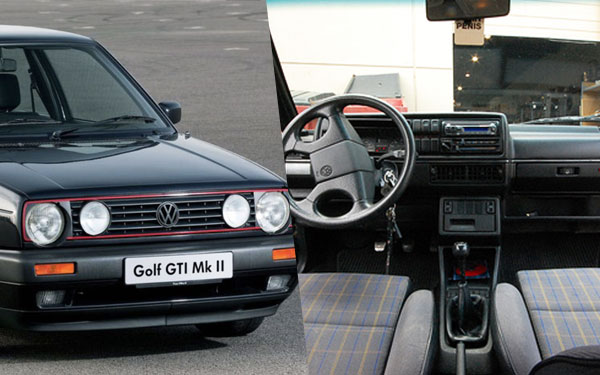
When VW introduced the GTI Mk2 in 1984, the racing stripe styling remained dominant, though tweaked a bit. Along with woven tartan fabrics, VW adopted the soft velour common throughout the 1980s and ‘90s (you know what we’re talking about. Those ultra-indulgent, soft-as-skin seats that you can just sink in to).
Take a look at this incredibly well-kept ’84 GTI, sporting bright red stripes on burgundy seats (yes, that’s an unbelievably cool red-on-red pattern for us color-illiterates), tucked away in an all-red interior. The whole interior really conjures up images of the bowels of hell. Needless to say, if you’re a fan of the color red (or a certain red, scaly creature with bifurcated tail), this thing is striking!
VW also produced some less vibrant – though still quite loud – velour seats like the red-on-blue seats below, also from an 84 GTI.
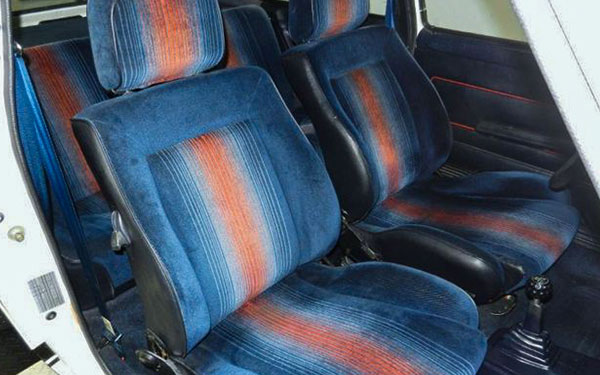
For the US market, VW also produced a few striped seats, like this black/white/red version from 1985.
In the UK, standard Mk2 seats continued to incorporate the tartan pattern throughout the model’s run, with light blue/yellow or subtle yellow/red on a soft grey background. However, even the UK versions got their share of ’80-ness, with full-on geometric patterns that would look quite natural in the home of Clark Griswold’s cool neighbors from Christmas Vacation.
Today, one of the more commonly seen Mk2 seat patterns is from its later years (late 80s/early 90s) – Recaro sports seats covered in a flat grey velour, with a deep red vertical stripe down the side, with ‘GTI’ stitched right in the middle, like these below:
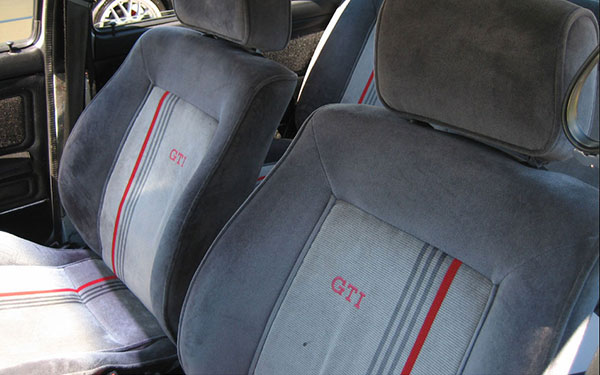
During the 80s, special edition GTIs also boasted their fair share of unique seat patterns. Pre-1990 GTI Campaign Editions came with the now-covetous rainbow pattern, the only model that sported this unique look and in 1990, VW introduced a new ultra-sporty GTI with their new supercharged G60 engine. These 160HP beasts all came equipped with Recaro racing-style seats.
MkIII – The GTI Goes Partying
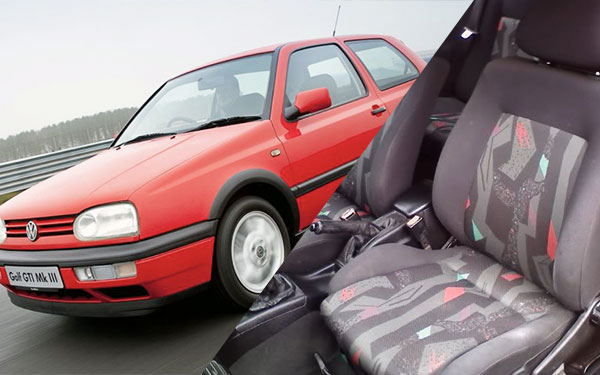
When Volkswagen introduced the new Mk3 in 1991 (1994 in the US), they took the same cautious approach they’d used with the Mk2 redesign roughly 10 years earlier. Keeping the basic exterior styling, they simply made the car bigger. With the GTI, the current 4 cylinder engine was simply too gutless for the new heavier car, so VW traded up for a new 6 cylinder (VW’s proprietary VR6).
For the interior trim, VW took a serious 90 degree turn. With the original 1976 GTI, Gunhild Liljequist and her design team sought to conjure feelings of sportiness, power, and quality with their tartan patterns in deep black and red. With the Mk3 however, those ideals seemingly took 2nd place to a few new ones: fun modernity (at least at the time), though still sporty.
For the first time, VW completely ditched the iconic tartan look. Suddenly we see bursts of colors like VW hinted at during the 80s. Bold stripes, checkered patterns, and geometric shapes strewn about the fabric. If the Mk2 is the Griswolds’ neighbors, the Mk3 has moved on to become Zach from Saved by the Bell.
In essence, the Mk3’s a party, and you can take your pick of party seats. In fact, the standard GTI seats as seen above are even known as ‘party seats’.
Looking for something a bit more subdued (but still not subtle by any means)? Check out these ‘sport plaid’ seats once for sale on VWVortex:
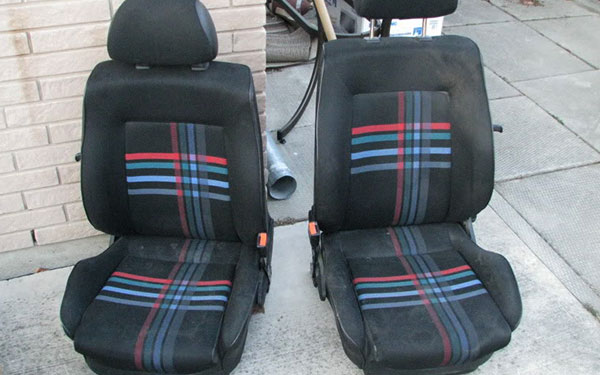
Still not your style? Well, here’s a strange tale from the forgotten vaults of history: VW actually sponsored concert tours for Pink Floyd, the Rolling Stones, and Bon Jovi during the mid-90s and produced special edition Golfs as part of the whole deal.
If you’re a diehard fan of the Rolling Stones, watch out for the ultimate show of support for these aging (or, aged) rockers: seats that advertise the band, a nice pair of which were once for sale on Orchid Euro.
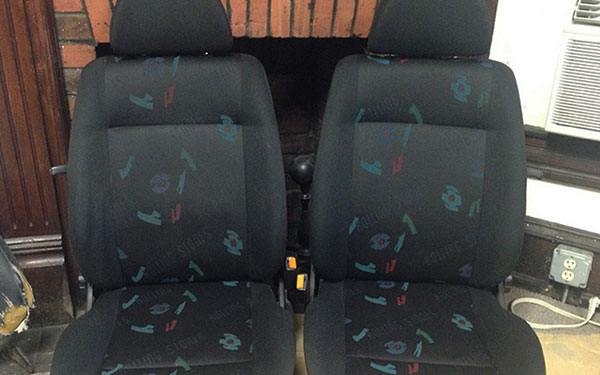
Keep in mind that these weren’t available in GTIs, but they’re still noteworthy nonetheless as a ridiculous bit of ‘90s-ness from Volkswagen. And who knows, you could always retrofit them in your GTI, right?
The patterns didn’t stop there though. VW also celebrated the 20th anniversary of the GTI in the mid-90s, and what better way to celebrate than create some nice limited edition checkered seats?
MkIV – Austerity Reigns
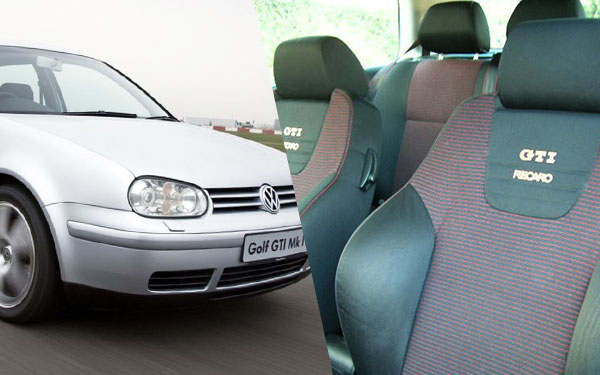
When VW introduced the Mk4 GTI in 1997, they calmed down a bit in the styling department. Instead of the ‘party style’ of the ‘90s GTIs, they stripped out multi-colors and patterns, opting instead for an under-stated black and red or black and blue look. This was likely a welcome change for the more refined of us and really pushed VW into the sleek, understated interior styling that’s so common today.
Up until 2000 or so, GTI Turbos sported cloth Recaro racing seats as standard, at which point VW switched over to their own in-house ‘sports seats’, presumably as a cost-saving measure.
MkV – Return to Form
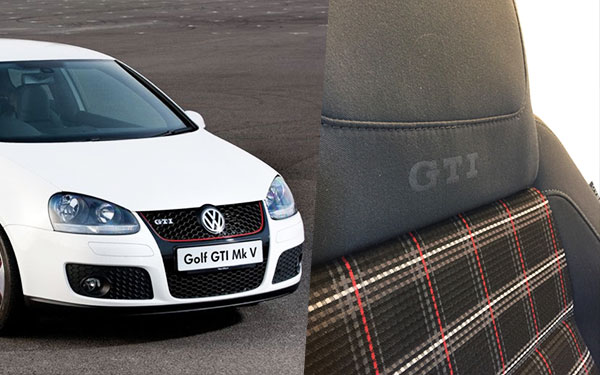
For the Mk5 GTI introduced in 2004, VW rode the wave of automotive nostalgia sweeping through the world (consider the retro styling of the 2005 Mustang, 2006 Dodge Charger, the 2007 Fiat 500, and so many more) and introduced many design throwbacks to that very first GTI way back in 1976. They re-added the red stripe around the grille and – most noticeably – reintroduced that classic red tartan pattern.
To celebrate the 40th anniversary of the GTI, VW also interviewed Manuela Joosten, a textile designer at VW who had a heavy hand in the interior designs for the Mk4 – Mk7 GTIs. Along with Gunhild Liljequist, she discussed the Mk5’s retro styling:
“For the Golf Mk V GTI we retrieved the original fabric from the archive and we have based our designs on it ever since. In the latest GTI we focused strongly on structure and a 3D look in order to create a modern yet instantly recognisable interpretation of the classic pattern… It is important that people recognise the Golf GTI as much for its interior as its exterior – and yet still see a new Volkswagen. It is the heritage aspect in particular that I find so fascinating about our job. So you think about what makes a GTI. To me, for example, the GTI is very much red…. red decorative lighting, red lines on the instrument cluster and in the door sills, red flat-felled seams, plus your (Liljequist’s) black roof liner.”
The new plaid fabric – which VW named Interlagos Plaid – was available as standard on all GTIs, with black leather as an optional upgrade. And of course, the plaid featured – you guessed it – red stripes on a black background.
Mk VI – Continuing the Tradition

From 2008 to 2013, the Mk6 GTI carried on the tradition of the Mk5, with the tartan (now called ‘Jacara cloth’) coming standard on all GTIs, with black leather available as an upgrade.
Honestly, there’s not too much to say here, at least in regards to the interior seating and trim.
Mk VII – Plaid Still Reigns
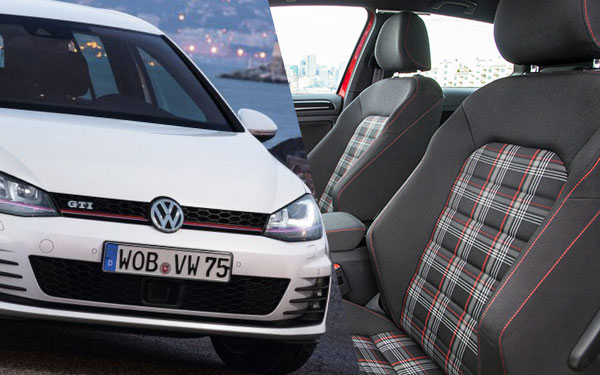
With the Mk7 GTI, VW again kept the style changes minimal, with plaid (now called ‘Clark Plaid’) coming standard, and leather coming optional or on higher trim levels like the SE or Autobahn (for MY2017). While the seats are a bit more angular than their predecessors and the headrest is tweaked a bit, there’s honestly not much difference between the two.
For the Mk7s interior styling, Volkswagen dove even further into the historical treasure trove, bringing back the golf ball-styling of the original Mk1 gear shift – again a nod to the unique flare of the original GTI just like the plaid seating.
And that’s brought us up to the current generation. All in all, GTIs have sported tartan cloth for 29 of its 42 years, so to say that this hot hatch’s image is wrapped up (no pun intended) in red tartan could be called an understatement. And like Gunhild mentioned, we think the tartan conjures up feelings of quality, while the deep red that lovingly adorns GTI’s interior fills the driver with a feeling of power.
Plaid History, Straight from VW
No car has a claim to fame on a day to celebrate all things plaid quite like the Volkswagen Golf GTI – thanks to one woman’s pioneering choices that over the past four decades have become a symbol of driving enthusiasts worldwide.
https://media.vw.com/releases/1213#
The Volkswagen Golf GTI’s debut in 1976 caused a sensation. Even though only a few details distinguished it visually from the original Golf, Volkswagen—influenced by one of the company’s first female designers—succeeded in transforming the compact car into an affordable sports car for the masses and capturing the mood of the era.
Gunhild Liljequist—a porcelain painter and chocolatier candy-box designer by trade—was hired on to Volkswagen’s Germany-based Department of Fabrics and Colors in Wolfsburg in 1964 when she was just 28. Her work focused on paint hues, trims and interior detailing, so when the first Golf GTI came into production in the 1970s, she was tasked with designing various elements of its interior from a sporting angle. Liljequist’s genius centered on giving the GTI two distinct, but simple, textile elements: a tartan seat pattern and a golf ball-style gear knob.
“Black was sporty, but I also wanted color and quality,” Liljequist said. “I took a lot of inspiration from my travels around Great Britain and I was always taken by high-quality fabrics with checked patterns … you could say that there is an element of British sportiness in the GTI.”
And the golf ball gear knob?
“That was a completely spontaneous idea!” Liljequist said. “I just expressed my sporting and golf associations out loud: ‘how about a golf ball as the gear knob?’”
Although her ideas faced some resistance, the tartan seat pattern, now known as “Clark Plaid,” and golf ball knob would become an iconic part of the GTI.
For a woman who personally loved just black and white patterns, color illuminated Liljequist’s professional world throughout her 30-year career at Volkswagen. The 1960s to the 1980s were a highly creative and experimental time in car design, and Liljequist’s work helped to influence some of Volkswagen’s most iconic paint hues, trims and interior detailing, while designing some special models of her own.
Beyond the Golf GTI, her two most notable contributions to the car world was her 1987 limited edition ‘Etienne Aigner’ Mk1 Golf Cabriolet—a car design influenced by the luxury maker of handbags, luggage and various other leather accessories—and her discovery of an iridescent, pearl color that she applied to a car’s surface, using a transparent foil. The metallic quality of paint on modern cars today is in part the result of Liljuquist’s experimentation in paint and coloring. Liljuquist retired in 1991, but her legacy is literally stitched into the fabric of Volkswagen.
Image Credits: Featured image courtesy VW Media , Exterior shots courtesy SpeedHunters , some interior shots courtesy VWVortex Forum – 1, 2, 3, 4, 5



1 Comment
[…] a new look. There are many different designs to choose from which can also have the look of seats from the GTI lineup of the Golf. It’s entirely up to you how you want them to […]